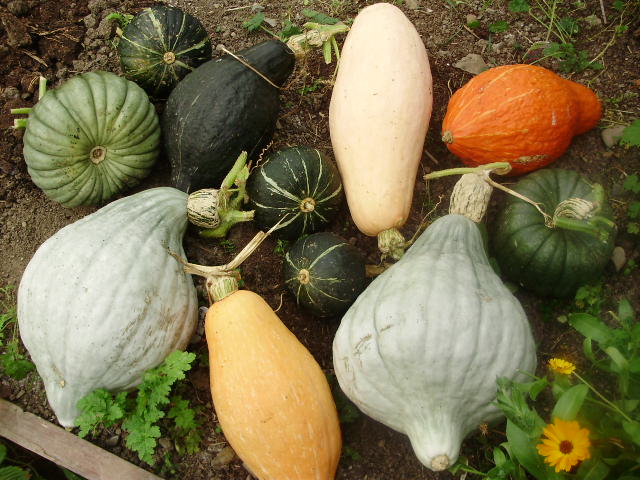
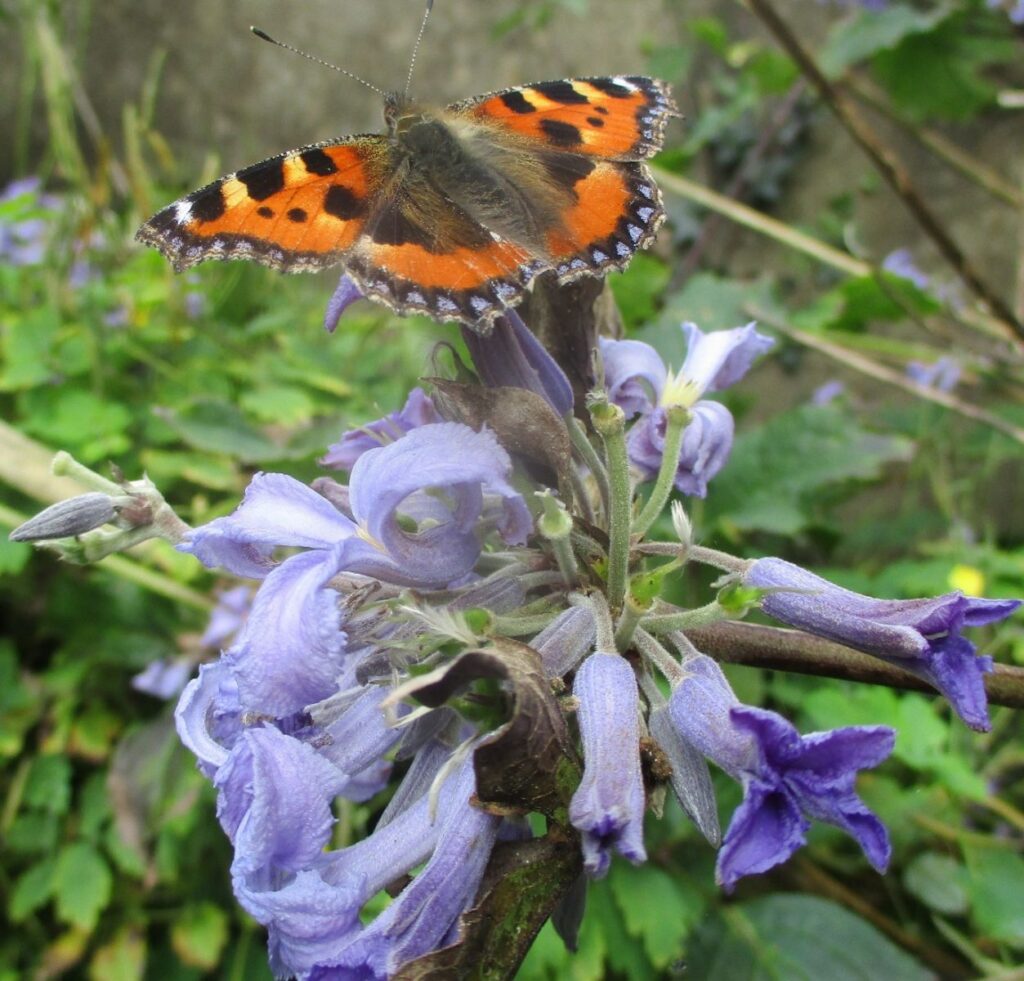
What a change in less than three weeks – and not just the weather, but on my blog too! Here, on the County Dublin/County Meath border in the north-east of Ireland, on our windy hill just a few kilometres inland from the Irish sea, during the first week of September, only three weeks ago, we had record temperatures, with Gerry Kelly and I enjoying recording our monthly ‘grow your own organic food’ chat sitting in glorious sunshine outside. Just a few days later, we had a week with 400% of the normal rainfall and ankle deep floods, two days ago we had gales so strong that I couldn’t open the polytunnel doors in case the wind ripped them out of my hand and the polytunnel took flight! Then early yesterday morning the thermometer was reading zero degrees Centigrade on the watermelon bed!
Our seasons are much less clearly defined now, and more unpredictable since climate change began accelerating more rapidly. Sometimes we almost experience all four seasons in a week. To misquote L.P. Hartley’s 1953 novel “The Go-Between”…“The past is a foreign country: they do things differently there” – How very different the climate was then – and how much I miss those gentler and more predictable, balmy early autumn days of my country childhood – which Keats’ verse below describes so perfectly:
Season of mists and mellow fruitfulness,
Close bosom-friend of the maturing sun;
Conspiring with him how to load and bless
With fruit the vines that round the thatch-eves run;
To bend with apples the moss’d cottage-trees,
And fill all fruit with ripeness to the core;
To swell the gourd, and plump the hazel shells
With a sweet kernel ………………..
…. Hedge crickets sing; and now with treble soft
The red-breast whistles from a garden-croft;
And gathering swallows twitter in the skies.
(John Keats)
However, this is such a wonderful time of year in the vegetable garden, polytunnel and orchard that we can still enjoy plentiful crops, if we learn to adapt to climate change. Growing at least some of our own healthy food is looking increasingly sensible – with extreme weather events happening more often throughout Europe and further afield, in whatever part of the world some of our fruit and veg is imported from. As a gardener, one naturally eats seasonally, which is far better for the planet. Often our biggest problem, despite the weather, is what on earth to do with all the produce which we’ve worked so hard to grow! But I never forget how fortunate we are to have that problem, and to still be able to grow food – when many around the world are being affected by climate change so much more badly than us – and have so little by comparison.
In addition to harvesting and preserving produce as fast as one can while on sticks – over the last four weeks I’ve also had to cope with the shock and huge stress due to the hacking of my website and potential loss of thirteen years work, which has led to massive changes and a lot of extra work. So this autumnal equinox heralds a new start on the blog, a fresh start with a new look, which I hope you will enjoy and find some helpful ideas which I have gleaned from my 45 years of growing and cooking organic food.
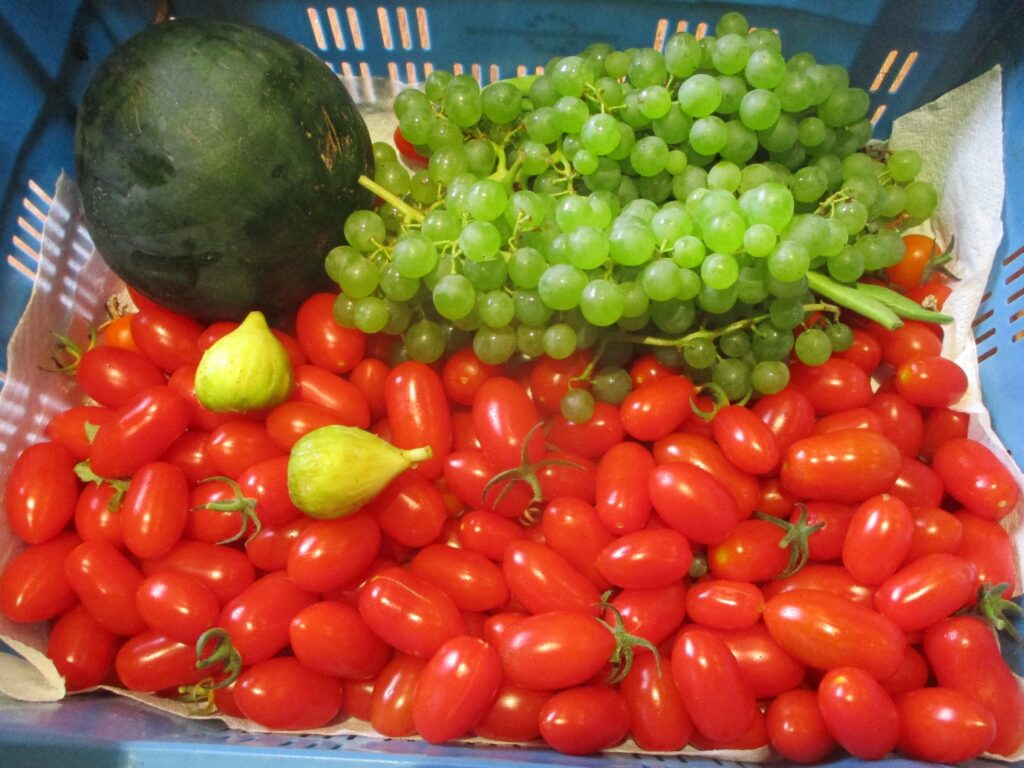
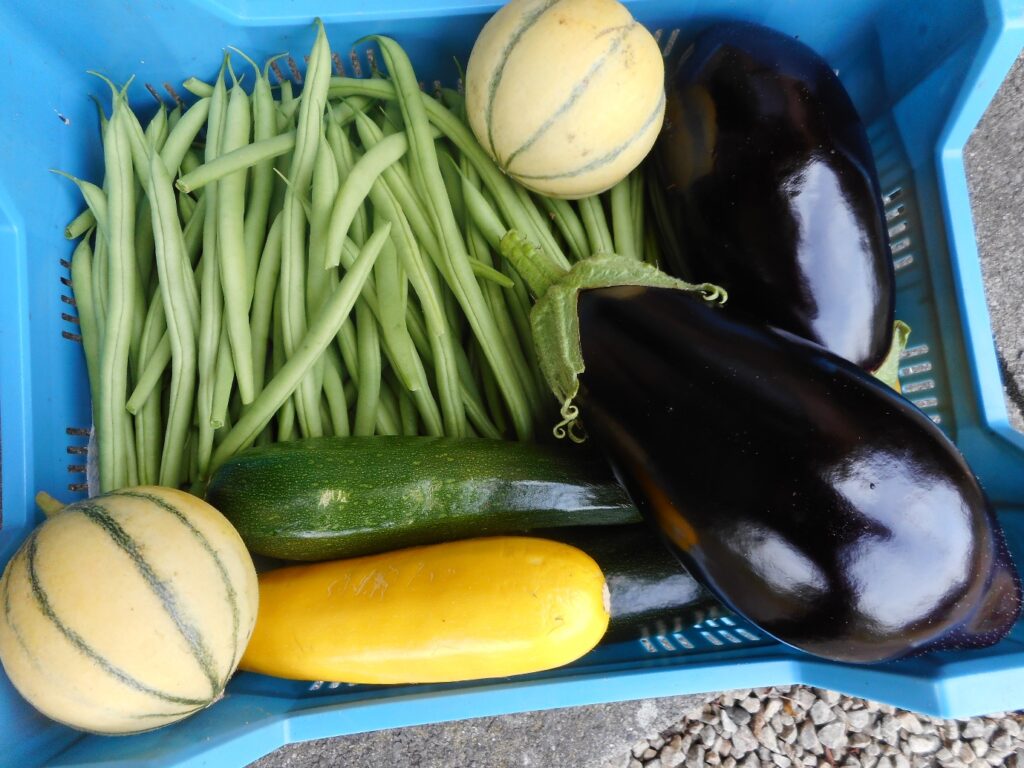
So, many apologies for the late arrival of this September blogpost – not my fault! The criminal hacking of my website four weeks ago has necessitated radical changes in the design and content of the blog, remedial work to recover thirteen years of lost content will be ongoing for a while, and the website will gradually evolve naturally.
Even though my website doesn’t sell anything, so no useful personal details would be available to criminals – apparently, these nasty parasites work by attaching some sort of Google bot to a trusted website link, which then drives more traffic to their site instead, and may introduce malware to unwary visitors. I think I’ve got the gist of it now – but I’m not into tech stuff! Anyway, let me assure you that after a lot of remedial work, this website is now encrypted and certified safe. At this point, I want to express enormous thanks to Keith Kingston of Ripthek Ltd, who has been making up for my woeful lack of tech skills for many years, and without whom I could not possibly have got this website problem sorted out. My patience and expertise are with plants and animals – I am allergic to computers!
At the same time, I already had even less time to do my gardening and writing than I normally would, with so much time being taken up by various appointments in different hospitals, due to log jams in the health service caused by the Covid pandemic. As many readers will be aware, I’m also currently partially disabled due to problems caused by old injuries from my days of retraining rescue horses – so everything takes a bit longer to do outside, especially in difficult weather when wading through floods! .
But ‘never give up or give in’ is my motto – and gardening is such great therapy for everyone, whatever their abilities – even for those like me, who aren’t quite as able as they used to be. It’s such a mindful, positive and productive occupation, that when I’m doing it, I tend to forget all my worries for a while – especially when accompanied by constantly entertaining Robins! It has scientifically proven mental health benefits too, and organic gardening naturally produces delicious, seasonal food to keep us healthy, at the same time as benefiting soil health, biodiversity, and the planet.
In The Polytunnel Potager
Early autumn is always quite a tricky time of year for growing in polytunnels, with summer crops like tomatoes still ripening fruits, but late autumn and winter crops increasingly impatient to be planted. It’s a delicate balancing act, this sort of halfway house between summer and autumn. As I mentioned in my regular monthly chat with Gerry Kelly three weeks ago, it is a time when we need what I call ‘seat of the pants’ gardening, and the flexibility to be prepared for any weather eventualities! You can listen to our chat here https://nickykylegardening.com/listen/
Tomatoes enjoyed the recent hot weather and have been ripening fast. I never de-leaf plants unless leaves are diseased or dying, or unless there is so much foliage that it seriously affects the air circulation so vital at this time of year, in which case I take off a few leaves to improve this. The plants themselves will show you what they need by yellowing of their lower leaves, which I then remove, as they are no longer of use to them. Healthy green leaves are still photosynthesising and making food for the plant, turning nutrients into sugars to feed growth and promote important phytonutrients in fruits. I don’t water or feed tomatoes at all after the end of September, as cold nights can reduce the temperature at their roots and cause them to quickly rot.
Conversely, September can often be exremely hot undercover during the day, with midsummer temperatures on sunny days – not what cool weather crops like salad veg and oriental greens enjoy. I tend to sow these in modules, to bring on outside, only planting inside when the weather has turned cooler. Growing them like this, they are ready to go in as soon as space is cleared for them, and the weather is cool enough. This means no gaps in cropping, and much more flexibility, something not just useful in life, but also vital for producing food crops. I must stress again that flexibility is something we need to learn from now on if we want to produce food reliably all year round, in an often erratic and changing climate.
Oriental greens such as Broccoli Raab, salad mustards and Mizuna grow gratifyingly fast, producing plenty of useful leaves very quickly for late autumn and winter in the polytunnel. I tend to grow these in slightly larger modules than small plugs, so that I have the flexibility to give them a couple more weeks of growth before they need planting, if the autumn is too warm. But they still need to be transplanted from their modules as soon as their root ball will hold together – before it becomes too congested and rootbound.
The best way to determine this without pushing them out and risking the root ball falling apart is to check the underneath of the module every few days. If roots are starting to emerge from the bottom to look for more soil, then this is generally a good guide. If you lightly squeeze the module, then push them up gently from the bottom, the root ball will usually come out easily in one piece when held by their leaves, rather than holding the tender stems, which are very vulnerable to bruising and disease at this stage. Once the root ball holds together well enough, this allows you to handle the module when planting without the compost falling off, which can shock the more sensitive plants.


If their roots have already filled their modules, and they urgently need planting before their space is ready, I will often pot the plants on into small pots to keep them moving and prevent them from getting a check which could trigger bolting. This can be tricky as you need to check every day, by checking one of the corner plants in the module tray, as if pushed out too early the module may break up and the plants will bolt, depending on how sensitive they are! If on the other hand they are left just a bit too long – becoming rootbound and hungry, then that will do the same!
While doing this may seem a lot of bother, it is well worth doing and prevents them becoming root bound which triggers bolting of fast-growing vegetables like Oriental greens, that tend to be more sensitive to this. Even if the weather is cool enough and space is ready at planting time – I usually grow more plants than I need and often plant half of the modules direct, potting on the rest either to plant somewhere else later or to give away. This acts as an insurance policy and ensures precious winter crops whatever the weather. Seedlings also need protection at this stage from birds scratching for worms, mice, slugs and sudden autumn downpours while still in their trays. Winter crops are so valuable that you’ll be so glad you took just a bit of extra care with them, when you eat the delicious results in midwinter!


Loose leaf lettuce like Merlot, Lollo Rossa or Jack Ice, Batavian, and other salad leaves such as endives, winter spinach, lamb’s lettuce, Claytonia and Oriental leaves are much the best value for winter salads in a polytunnel, as they can be picked just a few leaves at a time, as soon as leaves are large enough to be useful in salads. They will go on for months being harvested this way. I don’t grow any hearting lettuce in winter because once you have picked the head it is gone. I also find that soft butterheads and hearting lettuces such as Marvel of The Four Seasons are far more prone to rotting diseases like botrytis or grey mould in the damp humid weather so prevalent in our Irish winters.
If you haven’t sown any winter vegetables yet – don’t worry! There are still plenty of fast-growing plants you can sow now to produce food crops both from polytunnels and outside in the vegetable garden, later in autumn before the weather turns really cold. But with light decreasing rapidly after the autumn equinox, it is essential to sow them as soon as possible to get the best crops. There’s a full list on my ‘What to Sow Now’ page here: https://nickykylegardening.com/category/what-to-sow-now/

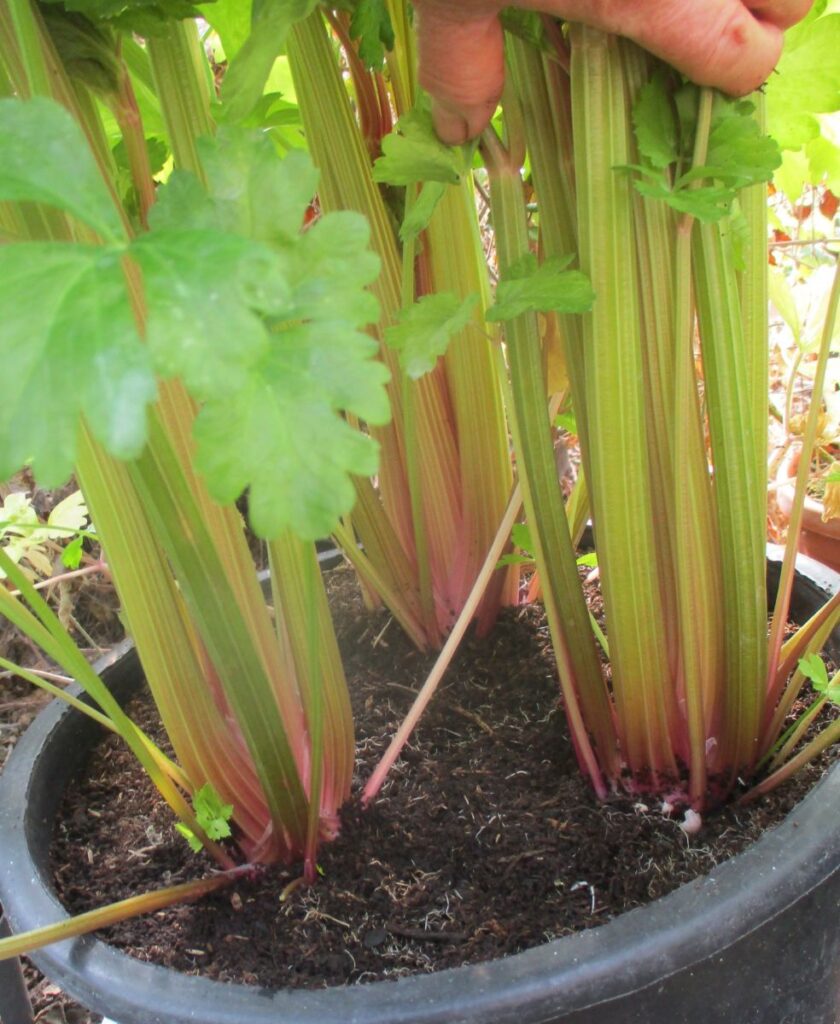
Celery is one of my ‘must have,’ most useful staple crops all year round, and as the weather deteriorates outside, I always have potted plants ready to plant inside as soon as summer crops are cleared, and for the last two years I have also planted some earlier between just-planted tomato plants. Then I water the roots of the celery plants rather than the tomatoes. This seems to work well, and they seem happy bedfellows. I cut down the tomatoes when they are finished, and the already large celery plants go on cropping all winter, picking just a few stems at a time.
One of the great things about polytunnels is they give us a flexibility (that word again!) which is so useful, ensuring reliable crops whatever the weather. When I grow celery in tunnel beds, I often interplant it with plants which enjoy the same damp soil conditions, such as land cress or watercress. I also grow it in tubs, especially when trying new varieties for the first time – often once again interplanting with watercress. Both are then kept very well-watered to prevent them drying out and they produce lush harvests. My favourite reliable varieties currently are Tall Green Utah, Unwin’s Pink, and Red Venture. These are all non-F1, open pollinated varieties, which you can saved seed from.
I sow celery twice a year – in early to mid-February to produce plants for growing outside in the garden with a few ‘insurance plants’ as I call them, to plant in the polytunnel between the tomatoes. Then I sow more in mid-June to plant in tubs and polytunnel beds for winter production. As it is very slow growing you need plenty of plants for winter, even if you are picking only one or two sticks at a time, which is the way I harvest it. Picking it this way ensures that the plants will last well into the following spring. It is almost the only plant in the polytunnel which I water just a little in winter. Remember that it is a bog plant naturally, and needs constantly moist, but not saturated, soil to be its tender best.
Celery is one ingredient in the Italian ‘holy trinity’ of vegetables, and along with carrots and onions make the basic ‘soffritto’ used in so many recipes which is indispensable throughout the year. It is brilliant for low-carb/low calorie snacking too – as incredibly, it takes more calories to digest than it actually contains! I eat it almost every day as it gives salads a great crunch. A delicious and filling food which is very low calorie, but also low carb, is a rare and valuable thing! There really is nothing like being able to snap off a turgid, crunchy stem to snack on while walking round the garden, or to look forward to in one of my lunchtime low-carb salad wraps!
In The Vegetable Garden
Work is mostly winding down outside now, with over-wintering crops planted, but make sure to cover any ground not already covered with a crop or a green manure, with a carbon-rich mulch like bark chips, to protect soil, prevent carbon loss and leaching of nutrients by heavy rain, and to keep weeds down.
Keep cloches and frost protection fleece ready to cover crops if frost is forecast. Suspending frost protection above plants on hoops or canes, rather than resting it on them, gives more protection from freezing.
Remember that even if you don’t have a garden, but only a balcony or just a path to your house, you can still grow almost anything in containers if they are deep enough to hold compost or soil for plant roots, and have drainage holes to prevent plants from becoming water-logged, and most importantly, if there is enough light. You can also make your own organic, peat-free growbags from bags of compost as I did this year with great results or make raised beds from old skip bags, or even a stepladder with a deep box on each step. Pests liked slugs and snails are much less of a problem to crops in containers, as they are raised off the ground.
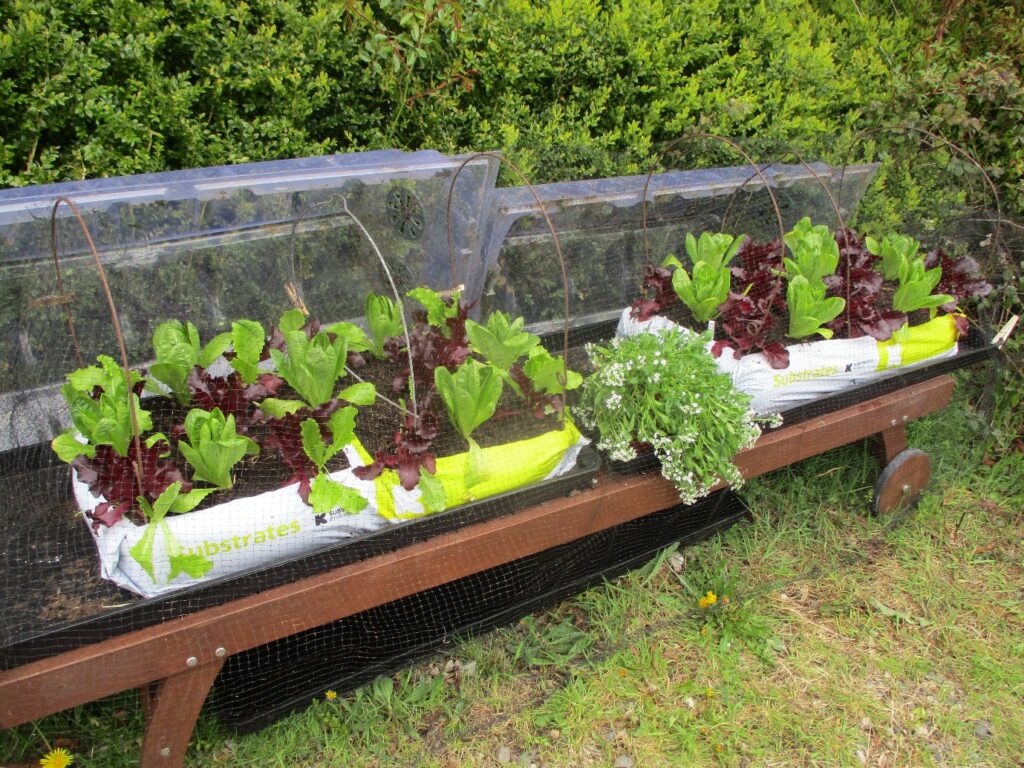
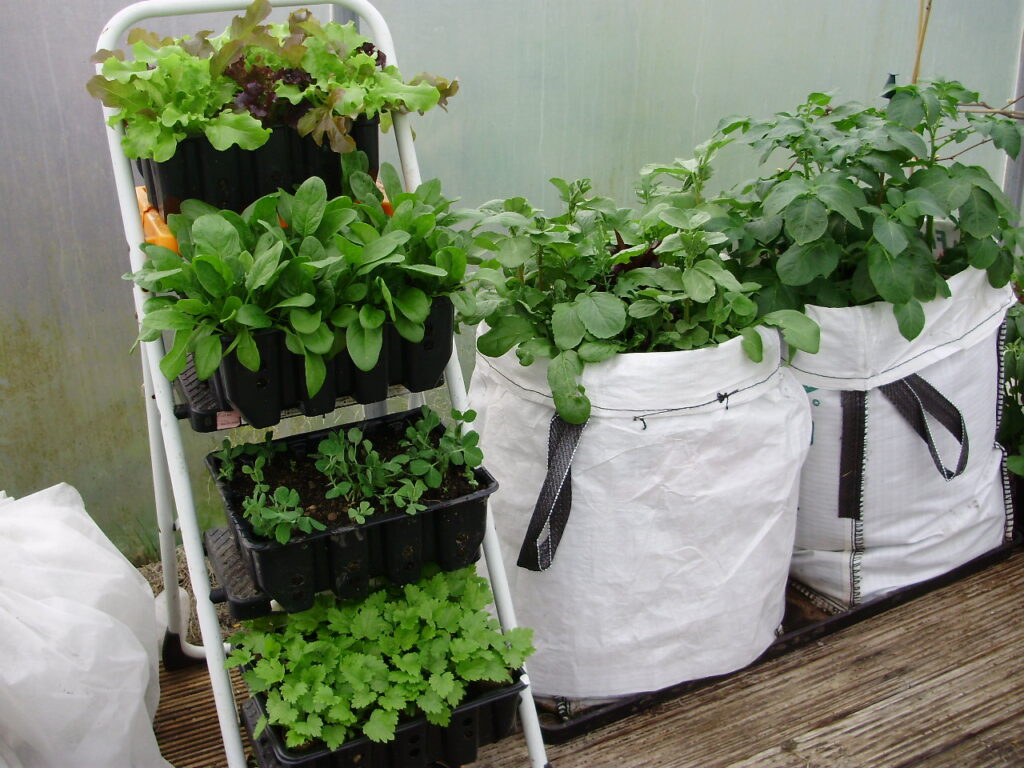
Mixing cops in containers can be fun as well as ornamental – but still productive, as long as they enjoy the same growing conditions. Even if you only grow enough to replace one meal a week in winter, or a few salads, with something you’ve grown yourself – that is food you won’t have to buy, and with household budgets under severe pressure as they are currently – every single meal counts!
In my monthly ‘grow your own organic food’ chat with Gerry Kelly, on LMFM Radio three weeks ago – we talked a lot about my new, homemade organic, Peat-free growbag raised bed project this year. You can find all the podcasts for each month, and for those from previous years, here: https://nickykylegardening.com/listen/
In The Fruit Garden and Orchard
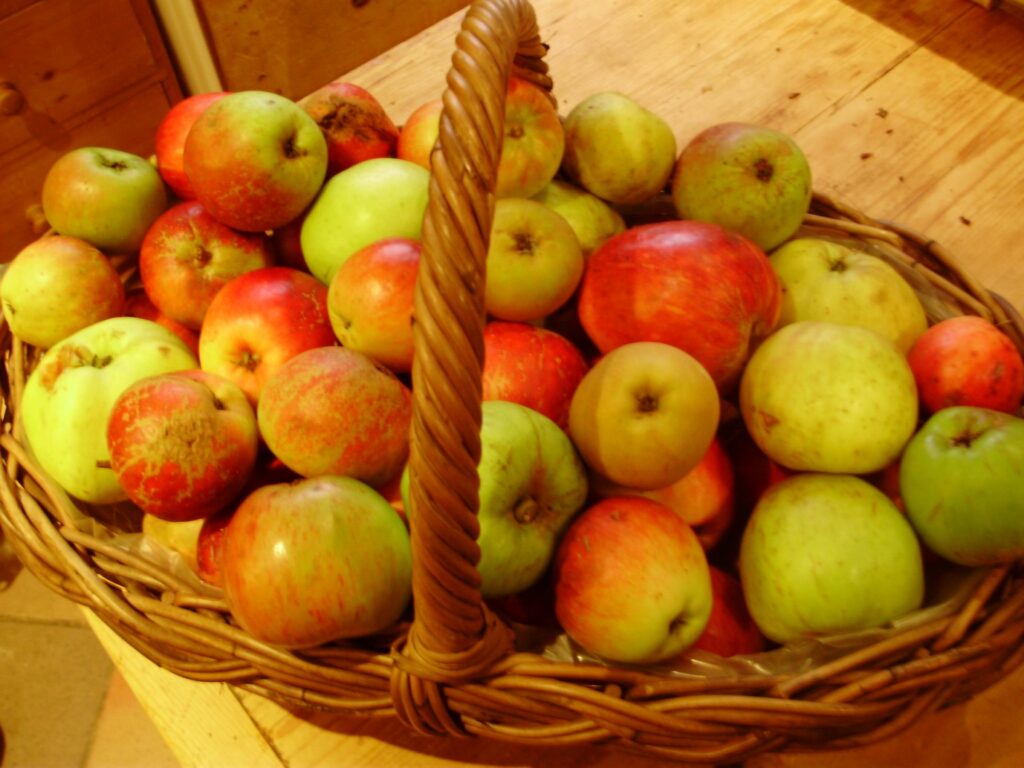
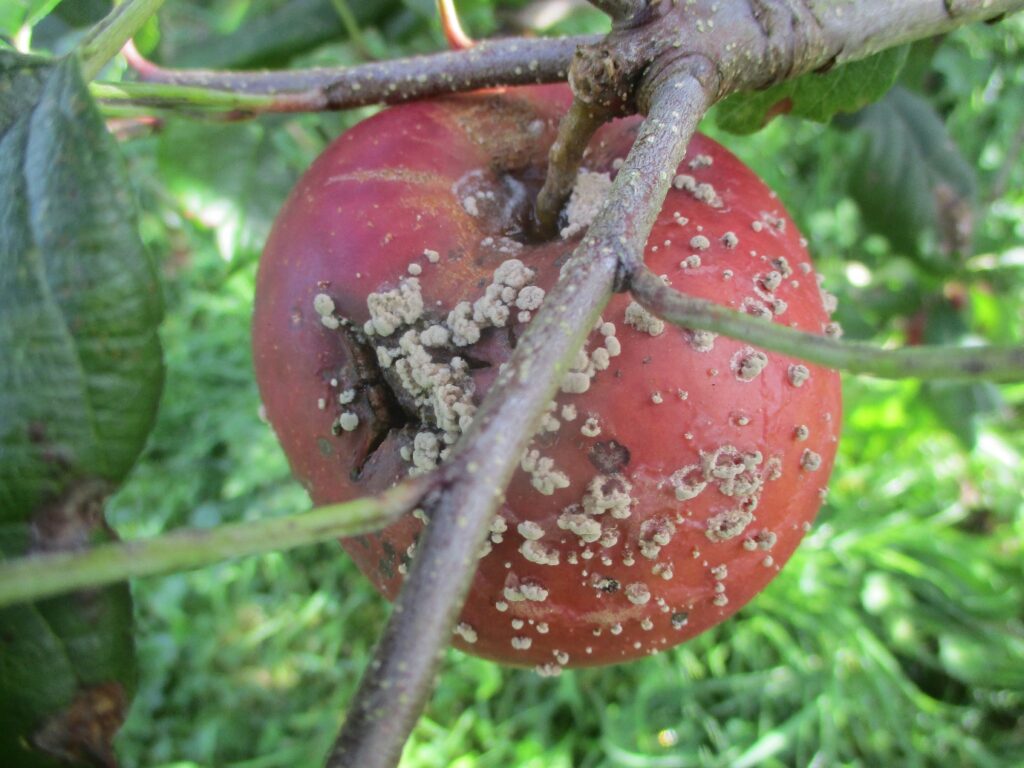
Early apples don’t keep for more than a week or two without losing their flavour. I walk around the orchard every day collecting windfalls. Damaged fruits won’t store and should be used immediately, or they can rot very quickly. We have far less tree fruit this year, due to our chemical-farming neighbour’s hormone weedkiller spray-drift in March causing many of the earlier flowering varieties of fruits like plums, pears, and early apples to abort their blossom. Shortly afterwards we had serious late spring frosts here which affected many of the later flowering varieties of apples too. Then recent torrential rain and gales have damaged them even more – so much so that many have developed brown rot on damaged fruits.
The increasingly erratic and unpredictable spring and summer weather caused by climate change is making the fruit gardener’s life far more difficult, with tree fruits like apples, pears and plums most vulnerable to sudden periods of unseasonal weather. Late frosts in spring can mean fewer pollinating insects around, and potentially less fruit as a result. If that is then followed by a long dry spell in June or July, fruits may ‘set’ and start to ripen their skins. Then if an unseasonal storm or deluge follows in August, as happened here this year, fruits will often crack or split – literally bursting at the seams! This leaves them open to pest and disease damage, even though at first glance damage they may appear to have healed, this is always where insects gain entrance, and then disease follows.
As a result, we need to keep a close eye on pest or disease problems on fruit trees and deal with any immediately. Brown rot is a case in point as it seems to have occurred on many people’s fruit trees this year. Apples, pears, and plums can be affected by this very infectious fungal disease, which can also infect branches, causing canker and dieback if not dealt with as soon as possible. If you see any fruits affected by this, it is vital to remove them immediately, before they drop to the ground, as the disease can lay dormant there over the winter and emerge again in spring when conditions are right, causing blossom wilt as well.
Dispose of rotting or mummified fruits immediately, preferably into your council green waste bin, or bury them at least a foot/30cm deep in the ground. Do NOT compost them, as very few domestic compost heaps heat up to a high enough temperature to destroy the disease-carrying fungal spores.

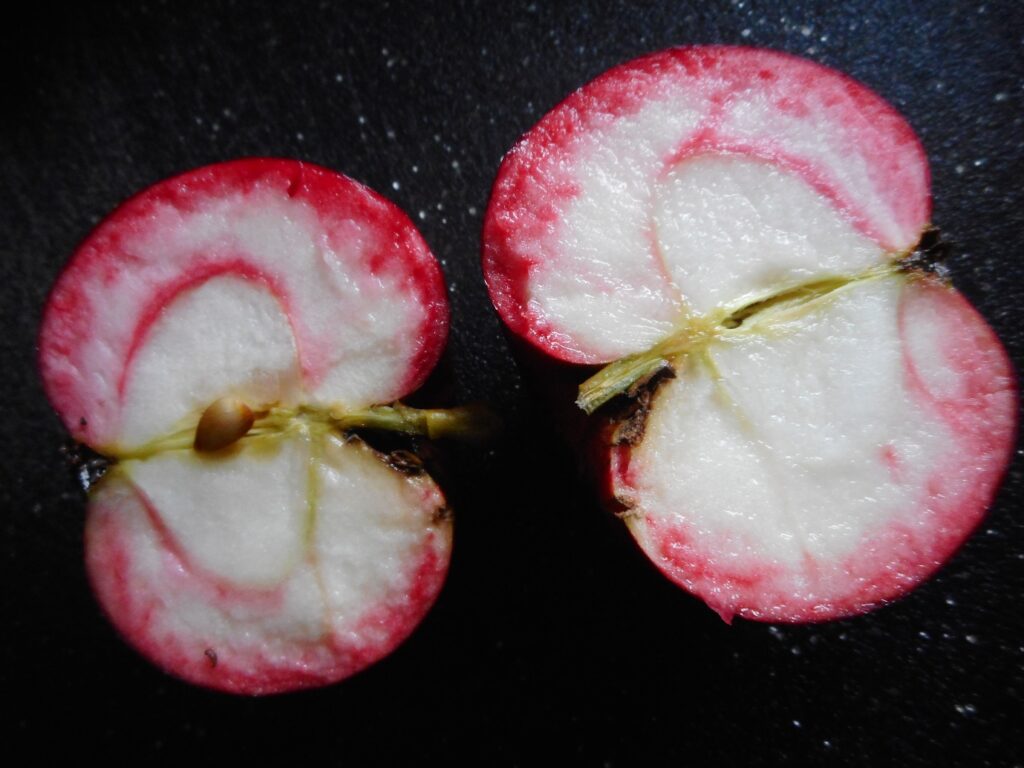
Red Devil is normally one of the most reliable and generous September apples, with delicious, pink-stained flesh illustrating its high, healthy polyphenol content. It always looks so beautiful silhouetted against the blue September sky – just like a child’s picture-book apple. It is normally heavily laden with fruits, but this year it has been very badly affected by the weather, carrying far fewer apples, with splits caused by the recent heavy rainfall, and the dreaded brown rot developing quickly on damaged fruits.
I walk around the orchard every day with a bag collecting any affected fruits, and no usable bits are wasted. They are dealt with immediately because every bit of fruit is precious this year and must be preserved for winter use. We try to be self-sufficient in apples here all year round, so even small pieces are useful for something – chutneys, baking, fruit leathers and smoothies etc. I remove any bad bits, toss them in lemon juice to prevent browning and then freeze or dehydrate them for use later.
My dehydrator is one of the best investments I ever made. It does a fantastic job of preserving fruits and vegetables all year round, making delectable treats like semi-dried fruits and tomatoes for winter salads, sultanas, or fruit leathers and even low carb crisps and crackers. It is also very useful for dehydrating chopped apples if I am short of freezer space, as some, like Grenadier, are perfect when just picked, but lose their flavour very fast.
In a few hours, the dehydrator can reduce seemingly vast volumes of produce to a much more manageable size, to either semi-dry and freeze, which is how I prefer them – or to dry completely. Apples which are completely dry will store in a useful state for years in airtight jars. At this time of year freezer space is always at a premium, with summer crops and autumn fruits like blackberries already taking up a lot of room.
I think what I love most about my dehydrator is that it goes on working while I am asleep. One thing is for sure – the work never stops in a grow your own food garden – but it is such productive, satisfying work with such delicious results!
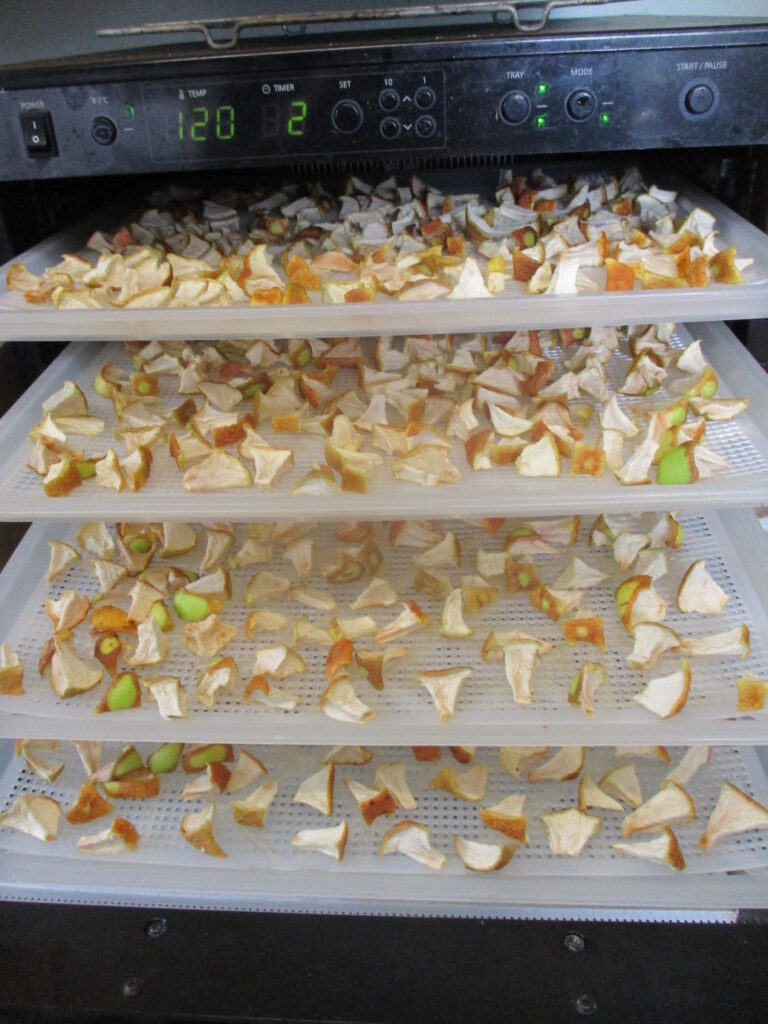

Other Jobs
Plant garlic – the sooner you plant it, the bigger the bulbs will eventually be. If possible, plant organic bulbs – these are far less likely to carry the dreaded onion white rot and other diseases, as organic growers are legally required to adhere to strict rotations, to prevent the build-up of pests and diseases – whereas chemical growers don’t have to do this and may grow continuously in the same soil. This in addition to the nasty pesticides they use, traces of which may still be present in the bulbs you buy!
It’s peak seed-saving time now! Saving seeds will save you a lot of money, which is useful in inflationary times. Collect seeds of open-pollinated vegetables on dry days as soon as they are ripe, and place in paper bags to dry. Tomato seeds need different treatment, with fruits left until very soft, over-ripe and ready to drop, so that the seeds can be rubbed straight onto paper towel and left to dry. And don’t forget to label them!
This is a good time to buy in organic peat-free seed compost – and also peat-free potting compost, if you have somewhere dry to keep it. It tends to be short in short supply in early spring when everyone else is ordering it and if so, may delay your early spring sowings.
Cut down runner bean roots and lift them just as you would Dahlia tubers, on a dry day before the first frosts, to store and replant for an earlier crop next year. (More on that next month).